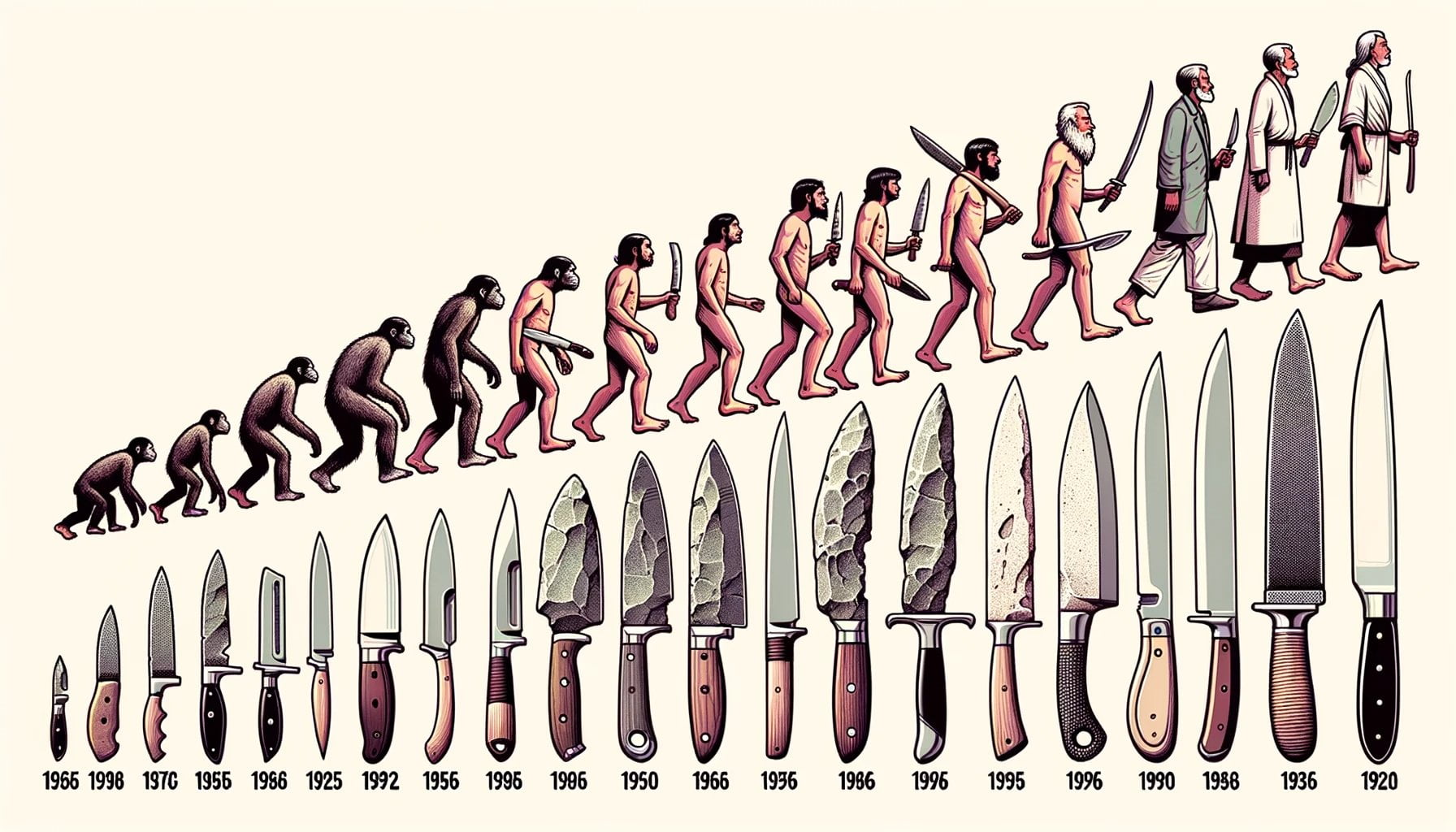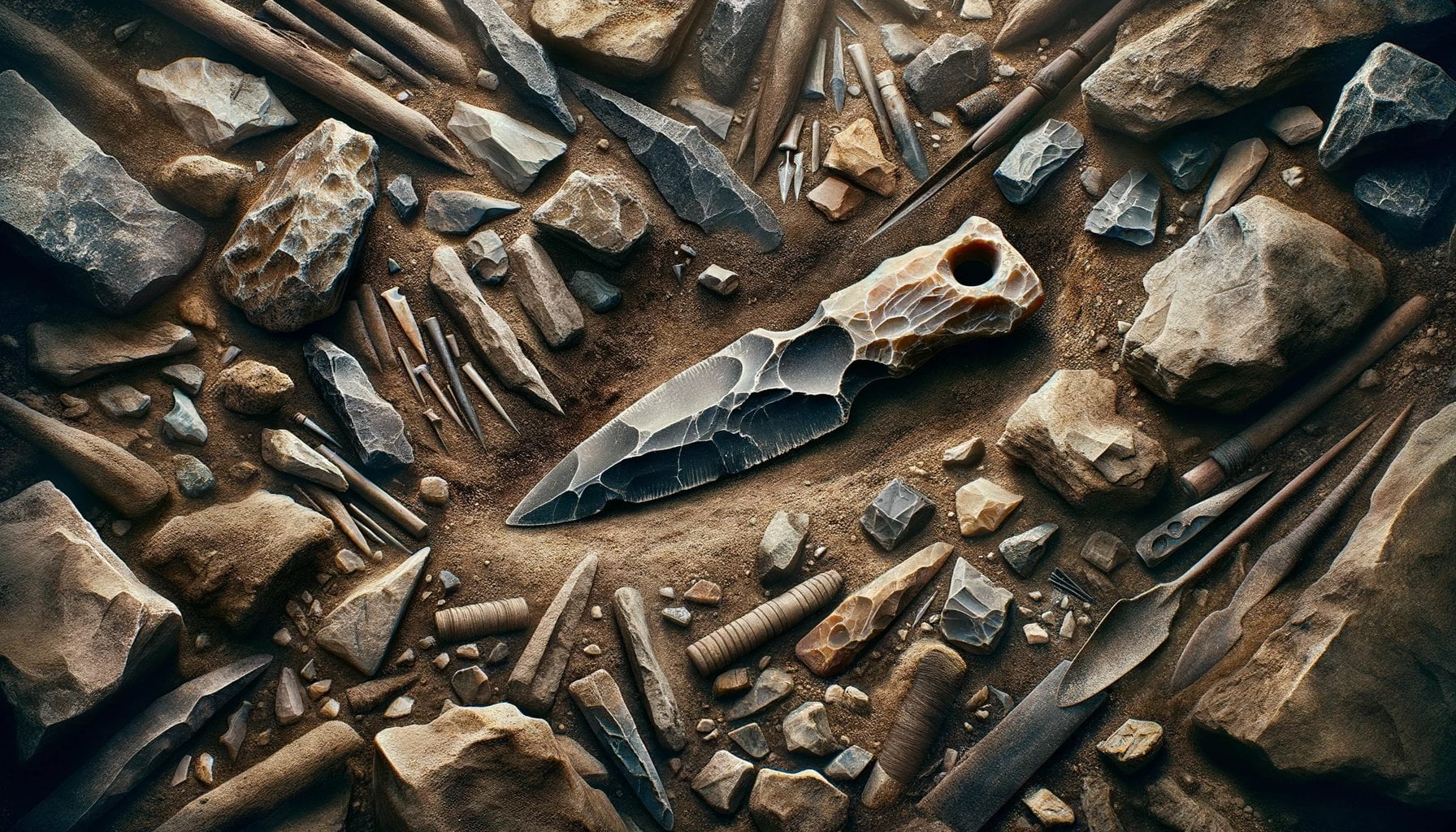Delve into the ancient realms of prehistory and discover the awe-inspiring secrets hidden within the most ancient knife. As an experienced archaeologist with a profound love for ancient artifacts, my expertise lies in unraveling the rich tapestry of our ancestors’ past. With a focus on primitive weaponry and an extensive knowledge of early human cultures, I embark on a journey filled with fascination and wonder, seeking to shed light on the enigmatic origins of this remarkable tool. Through meticulous research, excavation, and analysis, we aim to bring forth valuable insights into the ingenious craftsmanship of our ancient predecessors. Prepare to be captivated as we embark on this extraordinary exploration of the most ancient knife.
What is the most ancient knife?

The history of knives dates back to the early development of human civilization. Knives have been essential tools for survival and everyday activities throughout history. From hunting and cooking to carpentry and farming, this versatile tool has played a crucial role in various cultures.
The Oldest Known Knife-like Tool: The Oldowan
When we think about the most ancient knife, our journey takes us back an astonishing 2.5 million years ago. Archaeological discoveries have revealed the existence of the Oldowan tool industry, named after the Olduvai Gorge in Tanzania where it was first discovered. These tools, which were shaped by early humans or hominids, were primarily made from stone and served multiple purposes.
While not an actual knife in the modern sense, the Oldowan tool is considered the earliest-known precursor to the knife. These tools were chipped and shaped to form a sharp edge, making them suitable for cutting and slicing tasks.
The Emergence of Flint Knives
Over time, our ancestors began to experiment with different materials for creating sharper and more effective cutting tools. The earliest knives made specifically for cutting are believed to be flint knives. Flint, a type of sedimentary rock, was readily available and easy to shape into sharp blades. These flint knives were used for various activities such as butchering meat and carving wood.
Metal Knives: Revolutionizing Knife-making
As human civilization advanced, so did the technology behind knife-making. The introduction of metalworking can be considered a significant leap forward in knife development. Copper, being one of the first metals to be discovered and utilized, became the material of choice for crafting knives.
During the Copper Age, symmetrical double-edged daggers made from copper emerged, revolutionizing the concept of knives. These daggers were not only practical for cutting, but they also served as status symbols and ceremonial objects.
The Bronze Age: Single-edged Knives
The Bronze Age marked yet another milestone in the evolution of knives with the introduction of bronze, a stronger and more durable metal than copper. Around 4000 years ago, during this period, the first single-edged knives emerged.
Bronze knives were widely used for various purposes, including hunting, cooking, and carpentry. Their sharp blades and sturdy construction made them essential tools for survival and craftsmanship.
Materials and Handles: A Diverse Path
While the history of knife blades is captivating, the handles of knives also walked an independent path through history. Depending on the culture and time period, knife handles were crafted using different materials such as bone, antler, wood, or even precious metals. The craftsmanship behind knife handles tells its own unique story, reflecting the artistic skills and cultural practices of our ancestors.
A Necessity of Everyday Life
In ancient times, carrying a knife was as essential as carrying a mobile phone is today (albeit for different reasons). Knives played a central role in various aspects of daily life, from harvesting crops and raising livestock to self-defense and survival in the wild. They were tools that enabled humans to flourish and navigate the challenges of their time.
Through meticulous examination and analysis of archaeological findings, we can gather valuable insights into the remarkable ingenuity of our ancestors. While the exact origin of the most ancient knife may still be shrouded in mysteries, it is through the study of primitive weaponries and the artifacts left behind that we can paint a clearer picture of our prehistoric past.
Let us continue to uncover the fascinating history of knives and the innovations that have shaped our modern perception of this essential tool. The ancient knife stands as a testament to human ingenuity and a reminder of our enduring connection to our ancestors and their remarkable achievements.
Did you know that ancient daggers have a fascinating history? Explore the world of ancient daggers and their significance at Ancient Daggers.
Discussion on the Evolving Purpose and Design of Early Knives
The history of knives stretches back millions of years, with the earliest evidence of their existence dating back to the Stone Age. These primitive tools, such as the Oldowan Knife, were essential for survival and represented a significant milestone in human cultural behavior. As an archaeologist specializing in ancient tools, I am fascinated by the evolving purpose and design of early knives and the insights they offer into the ingenuity of our ancestors.
Exploring the Origins
The Oldowan Knife is considered the oldest known knife-like tool, dating back 2.5 million years. Made from stone, it featured a sharp edge for cutting and slicing tasks. However, it’s important to remember that the purpose and design of knives during this period were primarily focused on utilitarian tasks, such as butchering meat and processing materials.
From Flint to Metal
As time passed and human civilizations advanced, the materials and techniques used to create knives evolved. Flint knives emerged as the first knives specifically made for cutting. However, the introduction of metalworking revolutionized knife-making. Copper became the material of choice during the Copper Age, with symmetrical double-edged daggers crafted for diverse purposes, including use as knives.
The Bronze Age brought about significant changes in knife design, with the emergence of single-edged bronze knives. These versatile tools were widely used for hunting, cooking, and carpentry. The handles of these early knives were crafted from various materials, depending on the culture and time period. These included bone, antler, wood, and even precious metals, showcasing the cultural and artistic value attributed to these tools.
Cultural Significance and Symbolism
Knives have long held cultural and religious significance worldwide. Many societies incorporate knives into spiritual and religious ceremonies, representing aspects such as purification, sacrifice, and symbolic power. Japanese knives, renowned for their craftsmanship, are prime examples of the cultural and traditional importance placed on these tools. The meticulous sword-making process, involving three distinct steps, showcases the deep-rooted traditions and artistry associated with knife production.
The Continued Evolution
In contemporary society, the purpose and design of knives continue to evolve. Modern knives can be crafted from a vast array of materials, including iron, steel, titanium, and ceramics. Technological advancements have also led to the development of specialized knives tailored for specific tasks, such as hunting, fishing, and culinary arts. Furthermore, ergonomic designs have been implemented to enhance comfort and efficiency during use.
Appreciating the Journey
By understanding the history and evolution of knives, we gain valuable insights into their purpose and design in both ancient and modern societies. The meticulous examination and analysis of early knife artifacts allow us to appreciate the remarkable ingenuity of our ancestors and the vital role that knives played in their lives.
In conclusion, the purpose and design of early knives have undergone significant changes throughout human history. From the humble origins of stone tools to the sophisticated craftsmanship of Japanese swords, each stage represents a progression in both cultural practices and technological advancements. Exploring the evolving nature of early knives not only deepens our understanding of the past but also highlights the ongoing significance of these tools in contemporary society.
Exploration of the Materials Used in Ancient Knives
Throughout history, knives have been an essential tool for humans, aiding in tasks like hunting, cooking, and self-defense. The exploration of the materials used in ancient knives offers valuable insights into the remarkable ingenuity of our ancestors. In this article, we will delve into the fascinating world of ancient knives, examining the materials they were crafted from and the significance behind their use.
Materials Used in Ancient Knives
Ancient knives were crafted from a variety of materials, each offering unique advantages and reflecting the technological advancements of the time. Let’s take a closer look at some of the materials that were commonly used:
1. Stone: In the earliest days of knife-making, stone was the material of choice. Ancient civilizations, such as the Egyptians and the Mayans, utilized stones like quartz, flint, and obsidian to create sharp-edged blades. These stones were readily available and easily shaped into usable tools. Stone knives were particularly suitable for cutting and slicing tasks.
2. Bone: As civilization advanced, humans began to fashion knife handles from materials other than stone. Bones, such as those from animals, provided a sturdy and accessible option. The use of bone handles not only improved grip and control but also added aesthetic value to the knives.
3. Copper and Bronze: The advancement of metalworking revolutionized the art of knife-making. During the Copper Age, copper became the material of choice for crafting knives. Copper knives were durable and had excellent cutting capabilities. As technology progressed into the Bronze Age, knives made from bronze, an alloy of copper and tin, emerged. These single-edged bronze knives were widely used for hunting, cooking, and carpentry.
4. Iron and Steel: With the Iron Age came the introduction of iron and steel knives. Iron offered greater strength and durability compared to bronze, making it an ideal material for knife production. Steel, which is a combination of iron and carbon, further improved the sharpness and longevity of knives. Damascus steel knives, popular in the Bronze Age, showcased the exceptional craftsmanship and cutting proficiency achieved with the material.
Significance and Evolution of Materials in Knife-Making
The choice of materials used in ancient knives reflects the technological advancements and cultural practices of their time. For instance, stone knives symbolize the ingenuity and resourcefulness of early humans, showcasing their ability to adapt and utilize available resources. Bone handle knives, apart from their practical purposes, might have also held cultural significance or represented social status.
The progression from stone to metal knives demonstrates humanity’s mastery over metallurgy and the subsequent impact on tool-making. With the introduction of metals, knives became more durable, efficient, and versatile. The ability to forge and shape metals contributed to the advancement of various civilizations, enabling them to better navigate their environments and improve their quality of life.
As advancements in materials, such as iron and steel, continued, knives became even more effective and precise. The increased durability and sharpness provided by these materials made tasks like cutting, slicing, and butchering more efficient. This, in turn, contributed to the development of specialized tool-making and enhanced the overall productivity and capabilities of ancient societies.
In Conclusion
The exploration of materials used in ancient knives offers us a glimpse into the technological and cultural advancements of early civilizations. From stone to metal, the development of knife-making materials showcased humanity’s ingenuity and adaptability. Each material served a purpose, reflecting the needs and priorities of its time. By understanding the materials used in ancient knives, we gain a deeper appreciation for the creativity and resourcefulness of our ancestors.
Whether it was the earliest quartz or flint blades, the innovative bone handle knives, or the advanced copper, bronze, iron, and steel knives, the materials utilized in ancient knife-making played a pivotal role in shaping human history. As we admire the ancient artifacts that have withstood the test of time, let us be reminded of the significant contributions these knives made to our ancestors’ lives and the lasting impact they continue to have on our understanding of prehistoric cultures.
Insights into the Cultural and Social Implications of Ancient Knives
Archaeological evidence provides us with valuable insights into the cultural and social implications of ancient knives. These remarkable artifacts not only shed light on the technological advancements of early human civilizations but also give us glimpses into their social dynamics, cultural practices, and belief systems.
The Importance of Knives in Early Human Societies
Knives have played a crucial role in human history, serving as essential tools for survival, everyday activities, and even self-defense. The use of knives dates back at least to 400 BC, and the evolution of these tools has been closely intertwined with the development of settlement patterns and metalworking skills.
Social Connectivity and Symbolism
Ancient knives, similar to Swiss Army knives, suggest social connectivity among early humans. Stone tools, resembling Swiss Army knives, have been found in southern Africa and are believed to indicate strong social ties among our ancestors who lived 65,000 years ago. These tools highlight the long-distance social connections of early humans and their ability to maintain bonds across different regions.
Moreover, Roman pocketknives carved in the form of gladiators provide us with insights into ancient consumer culture. The artistic and symbolic value placed on these knives reflects the importance of knives not only as practical tools but also as objects of cultural significance and personal expression.
Honor, Power, and Violence
Knives have often represented honor and power in various societies throughout history. For instance, knife fighting was common in nineteenth-century Greece, with a majority of assaults involving knives. This prevalence points to the cultural and social implications of knives as tools of violence and control. However, over time, knife fighting declined in Europe starting from 1750 due to various social, legal, and political factors.
Evolution of Knife Design and Materials
The evolution of knife design, symbolism, and use has been explored through history, archaeology, and anthropology. From stone and flint to bronze and iron, knives have evolved alongside human civilization. The progression of materials reflects technological advancements and cultural practices of different time periods.
Early stone knives symbolize the early humans’ ability to adapt and utilize available resources. The introduction of metals revolutionized knife-making, making them more durable, efficient, and versatile. Moreover, the materials used in ancient knife-making played a pivotal role in shaping human history and continue to contribute to our understanding of prehistoric cultures.
Cultural Significance and Legacy
Knives hold cultural and religious significance worldwide. They have been used in rituals, ceremonies, and traditions throughout different cultures. For example, Japanese knives are renowned for their craftsmanship and cultural importance, with intricate designs and techniques passed down through generations.
Understanding the history and evolution of knives provides us with valuable insights into their purpose and design in ancient and modern societies. These artifacts not only serve as important tools but also as symbols of cultural identity, social connectivity, and personal expression.
In conclusion, insights into the cultural and social implications of ancient knives help us appreciate the remarkable ingenuity of our ancestors. Through the study of these artifacts, we gain a deeper understanding of early human societies, their technological achievements, and the interplay between culture, symbolism, and everyday tools. The legacy of ancient knives continues to impact our modern world, reminding us of our shared history and the significance of our ancestors’ innovations.

FAQ
Q1: What is the oldest known knife in history?
A1: The Ötzi knife, dating back to the 4th millennium BCE, is the oldest known knife in history.
Q2: What materials were early knives made from?
A2: Early knives were made from stones such as quartz, flint, and obsidian, and later had separate handles made from bone.
Q3: What were knives used for in early civilizations?
A3: Knives were important tools for early civilizations and were used for tasks such as hunting, cooking, and carpentry.
Q4: How have knives evolved over time?
A4: Knives have evolved from stone and flint to bronze and iron, and modern knives can be made from a wide range of materials such as steel, titanium, and ceramics.
Q5: What is the cultural significance of knives?
A5: Knives hold cultural and religious significance and have often represented honor and power throughout history.
- Sept 31 Myth: Unveiling Calendar Secrets - March 18, 2025
- How Long & Till December 18, 2025: Accurate Countdown Guide - March 18, 2025
- Discover Japanese Artists: A Complete History - March 18, 2025
















